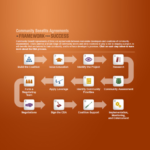Originally posted: May 11, 2020
Last updated: May 11, 2020
Section 5 includes tools designed to support practitioners working to institutionalize job quality practice changes within their own organizations, in the businesses they partner with, and across labor markets. Formal written commitments can help to set shared expectations and hold business and community partners accountable over time – including when economic conditions shift.
We are actively seeking tools to help practitioners establish job quality commitments and track them over time. If you have an actionable tool to share, please contact us so we can add it to our library.
↓ Tools and Resources Below the Box ↓
Library Navigation
- Job Quality Tools Library Homepage
- About This Library
- Special: COVID-19 Response Tools and Resources
- Index of Tools by Field
Tools

Partnership for Working Families – Community Benefits Agreements: A Framework for Success
Who’s It For: Economic Development, Investing and Lending, Worker Advocacy, Workforce Development
What’s It For: This framework is a guide to creating an agreement between community organizations and real estate developers to help meet local needs and hold developers accountable over time. Community Benefits Agreements can include job quality specifications, such as stipulated wages and expectations of hiring community residents. These agreements can also include job quality benchmarks in the selection of tenants for a new development. As legally binding commitments, CBAs can be a useful tool in setting and enforcing long-term expectations for job quality.
Supplemental Resources: Institutionalizing Job Quality Improvements
- The Aspen Institute Economic Opportunities Program – Linda Nguyen, Job Quality Fellow Profile. This profile describes Linda Nguyen’s efforts to establish Community Benefits Agreements (CBAs) during her tenure with Jobs to Move America, a policy advocacy organization. JMA has taken an innovative approach to CBAs, developing contracts with businesses that receive public infrastructure funding. This resource can be useful for practitioners exploring different ways to structure CBAs to support quality jobs as well as those interested in the intersection of job quality and environmental advocacy.
- Federal Reserve Bank of Minneapolis – Community Benefits Agreement. This resource outlines the origins, structure, features and limitations of Community Benefits Agreements (CBAs). This can be a helpful primer for practitioners exploring CBAs as a strategy to strengthen job quality. It offers guidance about how CBAs can be used and items to consider in their development.
- Good Jobs First and the California Partnership for Working Families – Community Benefits Agreements. This detailed resource from 2005 defines a Community Benefits Agreement, explains how to develop and implement one, shares the benefits and potential challenges of a CBA, and provides examples of existing CBAs. A CBA can include language that is meant to monitor and enforce job quality commitments with diverse partners across a local community. This resource can be useful as you begin to explore and understand the components of a CBA.
- JVS Boston – The Catapult Papers Essay #3. This paper lays out a potential path forward for “Next Gen” workforce organizations seeking to improve job quality for workers and elevate employer competitiveness. It shares the strategy, organizational culture, and field-tested practices that JVS Boston developed to engage employers in strengthening job quality and in turn more effectively meet employer and employee needs in a tight labor market.